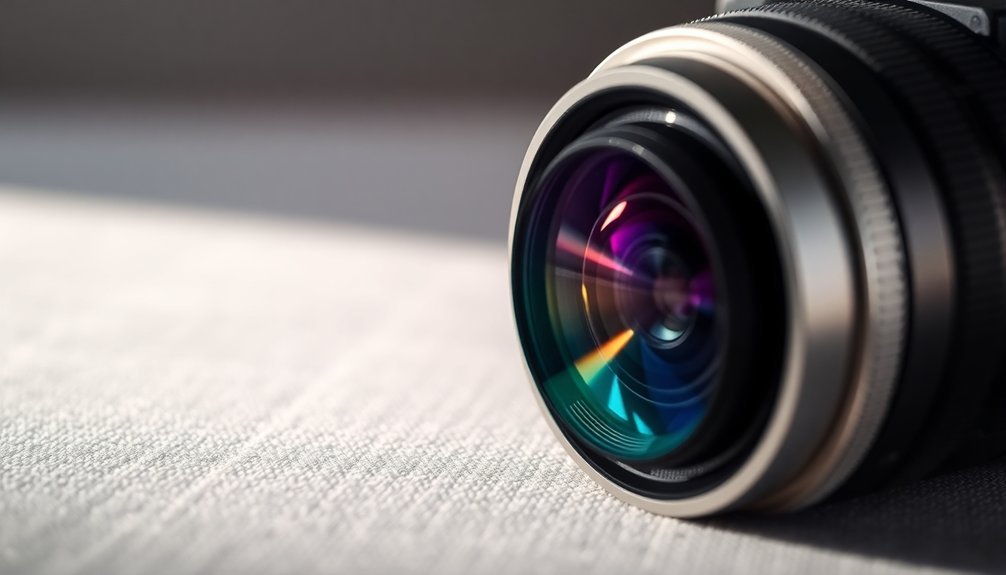When choosing a resolution sensor, you'll need to balance five key factors. Consider the trade-off between resolution and light sensitivity, as higher resolution means smaller pixels and less light capture. Match your sensor size to optical magnification requirements, and evaluate dynamic range needs for contrast. Select appropriate frame rates for moving specimens, and optimize pixel size for your documentation needs. These fundamentals will guide you toward making the best sensor choice for your application.
Understanding Resolution vs. Light Sensitivity Trade-offs

When selecting an imaging sensor, understanding the fundamental relationship between resolution and light sensitivity is essential.
You'll need to balance these competing factors carefully, as higher sensor resolution often requires smaller pixel size, which can impact light sensitivity and performance in low light conditions.
Consider that larger pixels provide better light sensitivity and higher full well capacity, leading to improved dynamic range.
If you're working in challenging lighting conditions, you might want to prioritize quantum efficiency over resolution, as sensors with higher QE values deliver superior low light performance.
When making your choice, remember that the trade-off isn't just about image quality; higher resolutions also demand more processing power and storage space.
For your specific application, a sensor with moderate resolution but better light sensitivity might deliver the best results.
Matching Sensor Size to Optical Magnification
Because optical magnification directly affects your imaging system's performance, matching the right sensor size to your optical setup is crucial.
Proper sensor-to-optics matching is essential for maximizing image quality, as magnification directly influences overall system effectiveness.
You'll need to take into account how your sensor size interacts with focal length to achieve ideal resolution using the formula: (pixel size/focal length) * 206.265.
While larger sensors can capture more light and provide wider fields of view, they aren't always the best choice.
Your optical magnification must align with your sensor's capabilities to prevent issues like vignetting. For instance, if you're using an APS-C sensor, you'll need to verify your focal length accommodates its size properly.
Remember that environmental factors can impact sensor performance, so choose a size that balances resolution with practical considerations.
A smaller 533 sensor might actually perform better than a larger one in certain optical configurations.
Evaluating Dynamic Range Requirements

Understanding your application's dynamic range requirements stands as a vital factor in sensor selection. When you're dealing with high-contrast scenes, you'll need a sensor that can capture both bright highlights and dark shadows effectively.
Machine vision sensors typically offer dynamic ranges between 60dB to 80dB, though this falls short of the human eye's 100dB capability.
To maximize your sensor's dynamic range performance, pay attention to quantum efficiency ratings. Higher QE values improve low-light performance, contributing to better overall resolution in challenging lighting conditions.
For specialized applications like scientific imaging or quality inspection, you'll want to take into account sensors with broader dynamic ranges. Remember that your sensor's ability to handle varying light intensities directly impacts image quality, making dynamic range evaluation essential for achieving ideal results in your specific application.
Selecting Frame Rates for Live Specimens
Selecting appropriate frame rates for live specimen imaging requires careful consideration of both movement speed and image quality needs. You'll need at least 30 frames per second for basic specimen monitoring, while faster movements demand 60 FPS or higher.
| Movement Type | Recommended Frame Rate | Camera Type | Resolution Impact |
|---|---|---|---|
| Slow Motion | 30 FPS | Rolling Shutter | Minimal Loss |
| Regular Motion | 60 FPS | Either Type | Moderate Loss |
| Rapid Motion | 120+ FPS | Global Shutter | Higher Loss |
| Ultra-Fast | 240+ FPS | Global Shutter | Significant Loss |
When choosing cameras for live specimens, consider both size and resolution requirements. Global shutters work best for fast-moving subjects, eliminating the distortion common in rolling shutter sensors. If you're working with limited light, remember that higher frame rates reduce sensitivity. You can use binning to maintain faster frame rates while preserving essential image detail.
Optimizing Pixel Size for Scientific Documentation
Three key factors drive ideal pixel size selection in scientific documentation: light sensitivity, image quality, and storage efficiency.
When you're optimizing pixel size for scientific documentation, consider using larger pixels (5-6 microns) to enhance photon capture, especially in low-light conditions. This size range offers an excellent balance between resolution and sensitivity while delivering high dynamic range with minimal noise.
You'll want to match your sensor sizes carefully with resolution requirements to avoid unnecessary costs and bandwidth usage.
For most scientific documentation needs, a 20-25 MP sensor resolution will serve you well, providing detailed images without creating overwhelming file sizes.
Remember to evaluate your specific imaging requirements, as the relationship between pixel size and resolution directly impacts your ability to capture and analyze fine details effectively.
Frequently Asked Questions
How to Choose the Right Sensor?
You'll need to match your sensor to print size needs, consider dynamic range for lighting conditions, and balance resolution with processing power. Don't forget to check compatibility with your optical system.
How to Calculate Resolution Sensor?
You'll need to multiply your pixel size (in microns) by 206.265, then divide by the focal length (in mm). This calculation gives you the theoretical resolution, but remember to take into account atmospheric conditions and tracking.
What Determines the Resolution of a Sensor?
Your sensor's resolution is determined by its total pixel count (horizontal × vertical), pixel size, dynamic range capabilities, quantum efficiency, and physical sensor dimensions. These factors work together to define image detail quality.
What Are the Three Main Parameters You Need to Consider When Selecting a Sensor?
You'll need to contemplate these three key parameters: resolution matching with optical components, dynamic range for scene gradation capture, and quantum efficiency for low-light performance when selecting your imaging sensor.
In Summary
When you're selecting a resolution sensor, you'll need to balance multiple factors. Consider your specific imaging needs – higher resolution isn't always better if it compromises light sensitivity or frame rates. Make sure you've matched the sensor size to your optical system and specimen type. Don't forget to evaluate dynamic range requirements and ideal pixel size for your documentation standards. Your choice will directly impact your research quality.





Leave a Reply